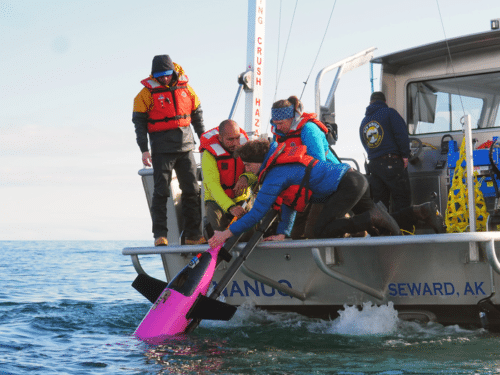A 7-foot-long, bright pink Seaglider has been developed in Alaska to measure ocean acidification.
The University of Alaska Fairbanks and its industry partners are the first in the United States to use an unmanned underwater vehicle to monitor carbon dioxide, the primary cause of ocean acidification. As humans burn coal, oil, and gas, the pH of the ocean is lowering globally. When carbon dioxide from these activities is absorbed by the water, it affects marine creatures’ capacity to create and maintain shells, as well as some fish behaviour.

Because the chilly waters of the Gulf of Alaska naturally contain more carbon dioxide, it only takes a small amount of man-made CO2 to reach a level that puts marine creatures at risk. Melting glaciers that discharge freshwater into the ocean can restrict the number of building blocks accessible to shells even further.
Despite the severe threat to commercial, subsistence, and sport fishing in Alaska, data on the state’s ocean acidification situation is sparse. “In order to understand how the human-made carbon dioxide in the atmosphere changes the oceans, we also need to know how ocean chemistry varies naturally throughout the year,” explained Claudine Hauri, an oceanographer at the UAF International Arctic Research Center.
In the past, technological restrictions limited study. From spring through fall, ocean moorings collected data at a single spot year-round, or ships sampled along transects for several weeks. Large portions of the ocean are rarely sampled, especially in the winter, despite the fact that these tools are still needed and give essential information.
Hauri and her colleagues designed a strategy to close the data gaps. They found a means to link a carbon dioxide sensor with a Seaglider that can dive to 1,000 metres and carry out weekslong expeditions to distant sections of the ocean in any season, working with worldwide business partners. “My job is to find the compromise between what the scientists want and what the glider can do,” said Ehsan Abdi, an electronics engineer with Advanced Offshore Operations Inc. and Cyprus Subsea.
“The most exciting thing is seeing such a big and power-hungry sensor go on such a humble and small glider that was not meant to do stuff like this,” said Abdi. “That’s why it’s challenging, and that’s why we’ve had so many problems. But that’s the fun part of it as well.” They intend to share the details of the sensor integration with others so that researchers all across the world can better understand ocean acidification and build more strategic and innovative responses.
“I’m excited by the possibility of having a whole fleet of these seagliders continuously measuring CO2. It’s important to have people from all around the world working on this, especially because it is a worldwide issue,” Kemme said.






